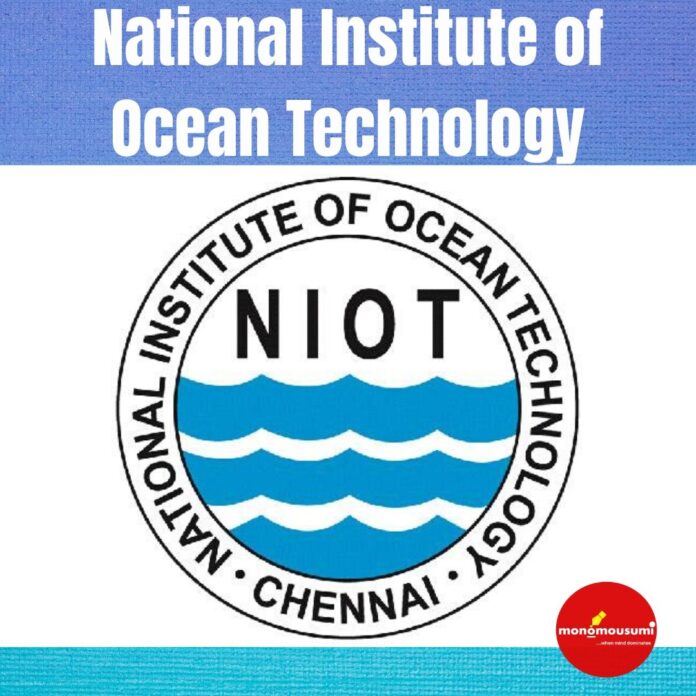There are many institutions in the world with their own purposes. Some are training institutions while others are research centers. They may be dealing with peace, conservation of resources, creating awareness, teaching others or maybe even exploring the world. One such research Institute is the National Institute of Ocean Technology (NIOT). It is based in Chennai, and was started in November 1933 under the Ministry of Earth Sciences (Government of India). Their main aim is to invent new technology, to revive and harvest non-living and living resources. Using technology, it makes it easier for them to collect resources and information about the deep oceans. They are also involved in managing ocean resources and saving the environment.
THE DEEP SEA TECHNOLOGIES
NIOT is an institution which provides a solution working, in the ocean. The Deep sea Technologies team are mostly involved in deep shaft mining and learning about the different types of soil found underwater. India is in need of mineral resources due to its growing population. The Deep Sea Technologies also called as Ocean Mining Group invent new technologies to support the need for resources in the near future. One of the pieces of tech they use is the Remotely Operable Soil Tester (ROSIS), using this they can measure the soil properties at 5500m depth. It is used to explore the sea bed. Their main aim is to provide the country with a source of energy. In the recent years the group discovered Gas hydrates, as an energy source. Gas hydrates is a new type of fossil fuel having an enormous amount of methane, providing two times more energy. In order to support excavation and exploration underwater, many devices like the Sub-sea transformer, Universal sub-sea latching system, Portable In-situ Soil Tester (POIST) and more were invented.
ROSIS ( Remotely Operable Soil Tester )
Photo: www.niot.res.in
FRESH WATER AND ENERGY SOURCE
The Ocean Mining Group takes care of finding new means of resources like Gas hydrates, hydrothermal sulphides and poly-metallic manganese nodules. All of these are non-renewable resources, now we need to find renewable resources. For this purpose, the group is finding ways to discover a new source of renewable energy. So far they are able to produce freshwater using Thermal Distillation process and produce energy through the Ocean Thermal Energy Conservation and Wave Energy. The energy is produced with the help of Backward Bent Ducted Buoy (BBDB). They have also had their focus on producing fresh water. The LTTD power plant produces Wave energy by running a turbine, which in turn produces fresh water. The LTTD (Low Temperature Thermal Desalination) is a very important piece of technology which is used to desalinate the water into drinking water in remote Islands like the Lakshwadeep. It almost produces 2-3 lakh liters of fresh water which is utilized by most islands. They have been successful not only finding energy resources, but also have been able to invent technology to produce drinking, fresh and useable water.
OCEAN OBSERVATION SYSTEM
Now the question comes, what else have they done for us that we are not aware of? Actually a lot more than you think. Our earth is made 2/3 by water and only 1/3 by land. That is a vast portion of water to discover. At first NIOT and other ocean research centers in the world had a difficult time to navigate around the ocean. Many put their heads together to find easier ways to discover the mysteries under water. After many technological developments NIOT was able to establish a high tech system which is known as the moored buoy program. The OOS (Ocean observation system) is a group which was formed in the year 1996 with an objective of operating and developing the moored buoy observational networks. This network is used to telecommunicate and observe the Indian seas. Presently, the OOS is able to overcome the challenges under water, they have even established a satellite based observation ( in-situ), tsunami warning applications, marine meteorology and bottom pressure records (BPRs). The OOS is now working on the OMNI (Ocean Moored buoys in the Northern Indian Ocean) which is equipped with high tech sensors. These sensors are used to measure the ocean currents, conductivity, and temperature up to a depth of 500m. The OOS has now established the CAL VAL Buoy system for satellite data.
Photo: www.niot.res.in
The NIOT formed the marine sensor group or system in 2005. They are entitled to develop the acoustic transducers which help to produce images for underwater applications. The group was able to successfully demonstrate the underwater acoustic imaging program and are working on developing the Helium Leak detector, Environment testing systems, Corrosion Chamber and Vibration testing chamber. They are currently using SONAR system to fulfill their goals of underwater sensing and imaging. Acoustics is not only used in this field of studying the ocean, it is also used to examine, study, learn and analyze the great expanse of the ocean. The ocean acoustic program was started with an aim to discover the ocean, through acoustic application, sound propagation, communication and acoustic application. They underwent activities like developing the vector sensor for signal estimations, upgrading and maintaining the existing NABL and installing the ambient noise stations along the east and west coast regions.
ENCOURAGING COMPETITIONS AND AWARENESS
The NIOT has been a hardworking institution that some of us know while others don’t. What else does the National institute of ocean technology give us? Well, they are not only involved in discovering the ocean but also conducts competitions for students, researchers and teachers every year. They encourage others, to spread awareness about the wonders of the ocean and what they could offer for us. Each year to encourage the students of class 10-12 are welcomed to enter a competition held by NIOT. It is a two day trip, a day for studying about the ocean and an insider of the various technologies that they have developed with their uses. The next day they were to present a chart and PPT on the topic they were assigned. There are many other competitions like this, such as the 3D modelling competition, an essay and cartoon competition and so much more. They also conducted a science activity for government schools, conducted a rally for the awareness of “Plastic free India”, workshops, International Science festival, swachchta Pakhwada (for cleaning the environment and preventing the usage of plastics) and cultural events. Many schools have visited their facilities over the years and learnt about the ocean. Right now the NIOT is providing students with live lectures, speeches and courses, during quarantine. The NIOT is not only involved in inventing new technologies but also is interested in saving the environment and creating awareness to others.
The National Institute of Technology has always had its aim towards inventing new technologies to uncover the mysteries under the water. Many groups are trying their best to always invent, discover, manage and investigate the seas. The NIOT is still working hard to fulfill their goals. They develop technologies, value added technical service and manage the ocean resources and environment. They also provide solution to organizations that are working in the oceans. They apply the technologies and utilize the ocean resources in a well sustained way. The NIOT is an institute that will thrive and make the world a better place.
BY Shamyukthaa P
















